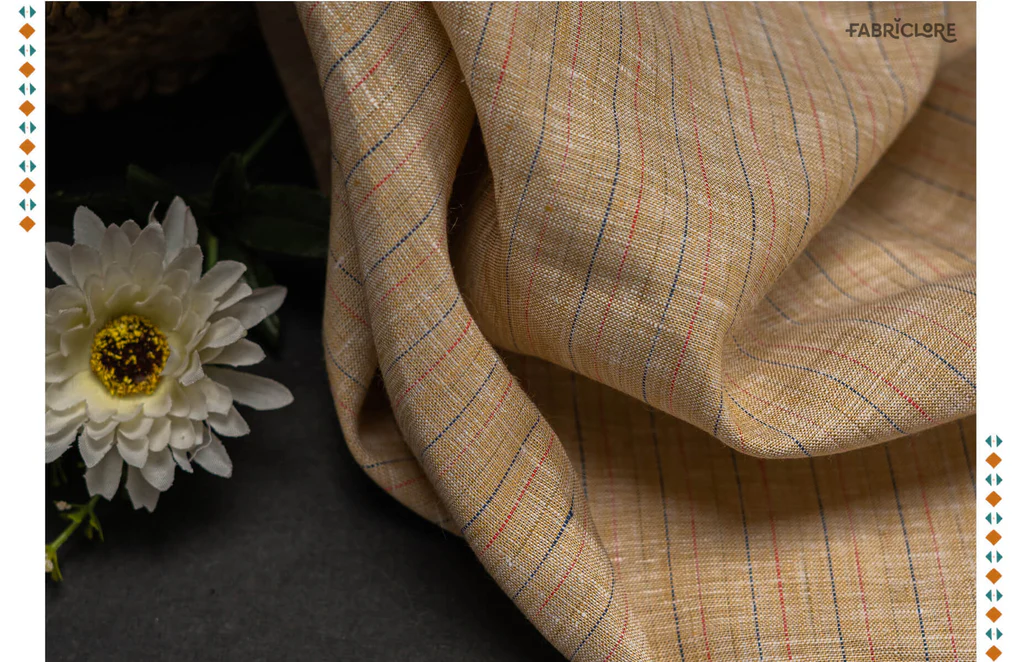Linen fabric has always been linked to beauty and quality, from the pyramids of ancient Egypt to the current styles of Paris. As a designer who has worked extensively with this remarkable material, A designer witnessed firsthand how linen continues to captivate both creators and consumers alike. Its timeless appeal lies not just in its natural beauty, but in its remarkable versatility and sustainable character.
1. Key Characteristics That Make Linen Unique
Natural Elegance
The first thing you notice about linen is its unique texture. The natural roughness of linen adds depth and character, in contrast to the similarity of synthetic fibers. Any design gains depth from these fine weave changes which create a living, breathing surface that captures the light in various ways during the day. The little slubs and natural differences that some may consider defects are exactly what draw designers to linen because they recognize that authenticity is the genuine core of beauty.
Exceptional Durability
Linen is a topic that often comes up when discussing design investment pieces. Every wash makes this amazing fabric softer and more supple while preserving its structural integrity. Each piece of linen that has been handed down through the centuries has maintained its fundamental beauty while narrating a tale of usage and time. For both heirloom-quality clothing and durable household items, its remarkable lifespan makes it the perfect option.
Breathability and Comfort
What sets linen apart in terms of functionality is its remarkable ability to regulate temperature and moisture. The hollow fiber structure creates natural ventilation, wicking away moisture up to 20% faster than cotton. This inherent breathability makes it an exceptional choice for both clothing and interior applications where comfort is paramount. As a designer, knowing that a material will perform well while looking beautiful provides an invaluable sense of confidence in our creations.
Sustainability
Linen is a shining example of sustainability in a time when being mindful of the environment is once again acceptable. Every part of the flax plant can be used, resulting in almost no waste and it requires very little water and pesticides for growth. In keeping with contemporary design principles, this natural fabric is also biodegradable, completing a circle of environmental responsibility.

2. Linen in Fashion Design
Casual and Everyday Wear
In everyday clothes, linen’s natural texture and fabric produce easily stylish designs, showcasing flexibility. Linen adds a touch of sophisticated ease to daily clothing, from perfectly large shirts to wonderfully rumpled pants. It is popular among designers who are making collections that combine comfort and style because of its ability to look both put together and relaxed.
Formal and Haute Couture
According to common opinion, when handled properly, linen looks great for formal attire. The distinctive texture and inherent elegance of linen are combined with silk or specialist weaving processes to create structured clothing that keeps its shape. The versatile nature of linen goes far beyond casual wear, as evidenced by the creative ways it has been used in recent runway designs for evening wear.
Seasonal Favorites
While linen is often associated with summer wardrobes, innovative designers are increasingly incorporating it into year round collections. Its temperature regulating properties make it suitable for layering in cooler months while its lightness and breathability make it indispensable for warm weather designs. Resort collections particularly benefit from linen’s natural ability to appear both refined and relaxed.
3. Linen in Interior Design
Soft Furnishings
Because of its natural variety and texture, linen is used in interior design to change environments. A sophisticated style is maintained while an inviting atmosphere is created with linen-upholstered furniture. Light is beautifully controlled by linen window treatments, which produce gentle, indirect light that improves any space. Linen bedding is both luxurious and useful; it keeps its structural integrity while getting softer with each wash.
Tabletop and Decorative Pieces
The dining experience is elevated through thoughtfully designed linen pieces. Table linens create an immediate sense of occasion, while their natural irregularities add character to formal settings. Decorative elements like linen lampshades diffuse light beautifully, creating warm, inviting atmospheres. The material’s versatility allows it to complement both minimal modern designs and more traditional decorative styles.
Modern Minimalism and Rustic Charm
Linen’s chameleon like ability to adapt to different design aesthetics makes it invaluable in contemporary interiors. In minimal spaces, its texture adds necessary warmth and interest without overwhelming clean lines. In more rustic settings, it reinforces natural themes while maintaining sophistication. This adaptability makes it a go to material for designers working across various style preferences.
4. Why Designers Love Working with Linen
Easy Customization
There is a great deal of customization possible because linen’s natural fibers easily absorb dyes and designs. Linen is a great medium for creating works of art if you’re making strong designs or delicate tone-on-tone effects. It is the perfect medium for creative design methods because of its capacity to maintain color while maintaining its special texture.
Cross-Industry Versatility
Few materials transition as seamlessly between different design applications as linen. Its success in both fashion and interior design speaks to its remarkable versatility. This cross-industry application allows designers to create cohesive collections that span multiple categories while maintaining consistent quality and aesthetic appeal.
A Canvas for Creativity
Working with linen inspires innovation through its natural properties and limitations. Its distinctive character challenges designers to think creatively about construction and finishing techniques. Some of the most iconic designs in both fashion and interiors have emerged from this creative dialogue between designer and material.

5. Linen’s Future in Design
As we look to the future, linen’s role in design continues to evolve. Technological advances in processing and finishing have expanded its applications while maintaining its essential character. The growing demand for sustainable luxury has positioned linen perfectly at the intersection of environmental responsibility and high end design. Innovations in blending techniques and finishing processes are opening new possibilities for this ancient fiber.
Conclusion
The forever attraction of linen is found in its special combination of sustainability, usefulness and beauty. It is an integral component in many cultures and times because designers appreciate its beauty, toughness and environmental friendliness. Because linen ages well, it produces items that appreciate and convey a sense of sustainable elegance. Materials like linen which combine history, practicality and minimal environmental impact are more important nowadays as design advances. Because of its timeless appeal, linen is essential to intelligent, long lasting design.
















Leave a Reply